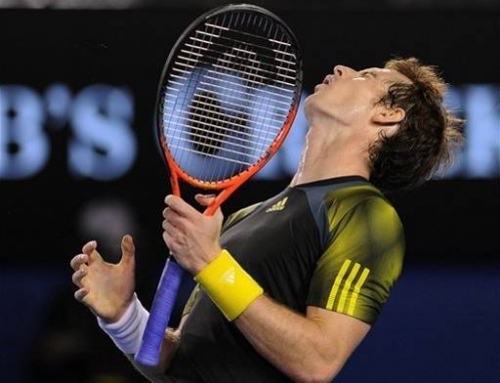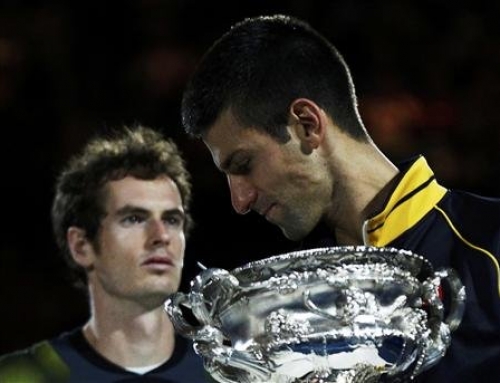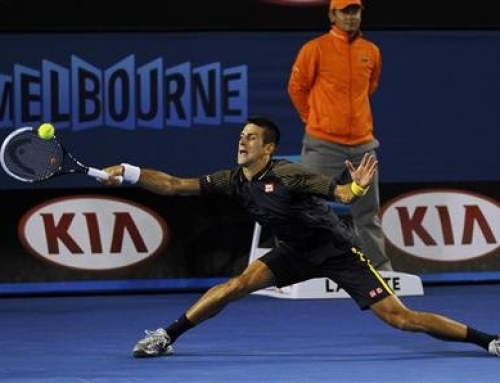With so many matches, I can only see a handful of them, especially with the time-zone differences.
The first match I watched was Andy Roddick playing Thiemo de Bakker. After a while, it seemed clear that de Bakker played a nervous first set. He didn’t hit the ball cleanly, nor that smart. Hitting ill-advised drop shots and not putting the ball away when he had opportunities, de Bakker looked as if he needed more lessons in strategic play.
By the second set, de Bakker upped his level of play, but it wasn’t enough. As Roddick has aged, he understands that he doesn’t have the kind of explosive game that puts opponents on their heels. He cobbles together a bunch of different pieces that allow him to win.
Those pieces center around his serve, which is still one of the biggest in the game. He serves fewer aces than he used to, but seems content to mix it up more. Roddick served only 7 aces to de Bakker’s 17.
Roddick explained his strategy afterwards. He wanted to play patient enough to let de Bakker make the errors, but aggressive enough so that de Bakker wasn’t able to dictate play. As Roddick has gotten older, he’s more patient. Even before he paired up with Stefanki, Roddick was winning by being patient. Stefanki has Roddick doing two things. First, he wants Roddick to play more shots to his forehand, so Roddick is running around the backhand more. Second, he wants Roddick coming to net more. This is a challenge since Roddick, despite his big serve, has few natural instincts coming to net. But Roddick is a smart guy, and he understands that since he lacks the big shot off the ground, coming to net is one way to finish points off sooner.
de Bakker, for his part, did something interesting. For as big a serve as Roddick has, his overhead is rarely put away. de Bakker opted to lob Roddick, and found opportunities to get Roddick’s overheads back. One reason Roddick’s overhead may not be that good is his former reluctance to come to net. Whether his future opponents will try to lob him remains to be seen. Given how well players pass, it would seem an unlikely option.
The other match I watched was Andy Murray playing Kevin Anderson. Anderson is from South Africa, but played collegiate tennis in the US. He played for the University of Illinois about the same time John Isner played for University of Georgia. Like Isner, Anderson is a tall player (6’8″) but moves pretty well for his height. You don’t get the same lanky feel with his game as you do with Isner. For a man Anderson’s height, he doesn’t hit huge serves. Indeed, serve stats show that Anderson and Murray hit about the same pace on first serves. Anderson only had 2 aces in this quick match.
Statistically, Murray is near the very top of return statistics, including how often he breaks his opponents. He’s up there with Rafael Nadal. This stat is somewhat deceptive. Murray plays an unusual style of tennis. While most players are content to play power tennis, Murray mixes up his shots. In the first set, he was looping shots without that much power. Murray often relies on his speed to chase down shots that look like winners and force his opponent to hit another shot. At times, it feels like Murray intentionally hits a softer shot to his opponents so they will be baited into attacking him, and then he can attempt to pass them.
This is a peculiar strategy, but it works best against players like Anderson. Anderson, like other players, takes Murray’s shots and powers them when he gets the chance. It’s more common to see Murray scrambling to get shots, and you feel that the reason is Murray brings it upon himself. Although the score says Murray routed Anderson, which he did, Anderson wasn’t so much overpowered, because that’s not Murray’s game, but either pressed into making errors, or Murray pulled out a great defensive shot.
Murray’s game has some interesting limitations. Murray isn’t the ultra-consistent hitter that Nadal or Davydenko is. Obviously, he can hit a few balls in a row, or he wouldn’t be in the top 10. However, you’ll see the depth of his ball strike vary a bit, and some of it looks unintentional, as if he meant to hit a deeper shot. He doesn’t have the kind of rock steady mechanics of Davydenko.
Murray relies a lot on his foot speed and anticipation, but to do that, he often does stuff like hit a slow looper, mixes in slices, hits drop shots. When his game is working well, his opponents make more errors than they are used to, and probably never feel like they are in good rhythm. On the other hand, if his opponent is striking the ball well, and Murray has been vulnerable to such players, then Murray doesn’t have a power mode where he can trade blows, nor does he have an ultra-steady mode to wait for the error. There’s even a lack of precision with his two-hander. A top two-hander can hit the down-the-line backhand repeatedly and reliably and it becomes a huge weapon. Davydenko, Djokovic, and Nadal can hit this shot (Nadal does it far less than either Djokovic or Davydenko). Murray can too, but he doesn’t do it that much. Where Davydenko often pulls the trigger to end the point quickly, Murray’s style (or for that matter, Nadal’s style) is not the same. This is the kind of game that makes people wonder if he can beat the big hitters or not. What weapons does he bring when his junkballing isn’t as effective as he’d like?
The big question for the day was del Potro’s wrist. Murray had a wrist issue and it may have affected his effectiveness at the US Open. del Potro found himself playing a bit of a tough four setter against Michael Russell. To be fair, this is a first round match and del Potro hasn’t had much match practice since November. It’s tough to read too much into the state of his game in this round. However, it is of some concern that he needed four sets to win.
Nadal looked like he had a tough opening set against Luczak, but won the tiebreak easily and took the next two sets easily. Although Nadal hasn’t won a tournament in ages, he’s reached a few finals. And honestly, for a set or so, he looked fantastic against Davydenko. At this point, Nadal’s game seems like it’s a lot better than it was in November when he lost all three round robin matches in straight sets. As usual, Nadal seems to prefer having his matches in the evenings. Don’t be surprised if he is the marquee player more evenings that most. Players like Roddick, Murray, and Federer will want to play their matches in the daytime with the heat and use their superior conditioning to win matches.
Two players that played well last week showed that momentum sometimes isn’t all that it’s cracked up to be. Radek Stepanek was a finalist in Brisbane two weeks ago, but had to face Ivo Karlovic. Although he’s never lost to Karlovic, he’s played him very close. This time, Stepanek wasn’t as lucky and lost to the Croatian in five sets in the first upset of the tournament. Still, Karlovic is such a dangerous player that it’s hard to call it a huge upset. Mardy Fish reached the semis of Sydney last week losing a close one to Marcos Baghdatis.
He played Andrey Golubev for the first time. Ranked 131, Golubev won in 4 sets over the much higher ranked Mardy Fish.
So far, the top players seem in pretty good form. There’s no upset comparable to Maria Sharapova (and really, is that such a huge upset, with Sharapova’s error-filled game?) yet.
We’ll see how Day 2 turns out.






![[Aussie Open Final] Can Andy Murray beat Novak Djokovic?](https://www.essentialtennis.com/wp-content/uploads/2013/01/20130126andy-500x383.jpg)
![[Day 13, Aussie Open] Bryan brothers win 13th Slam with Aussie doubles title, Kyrgios wins boys title](https://www.essentialtennis.com/wp-content/uploads/2013/01/20130125bryan-500x383.jpg)